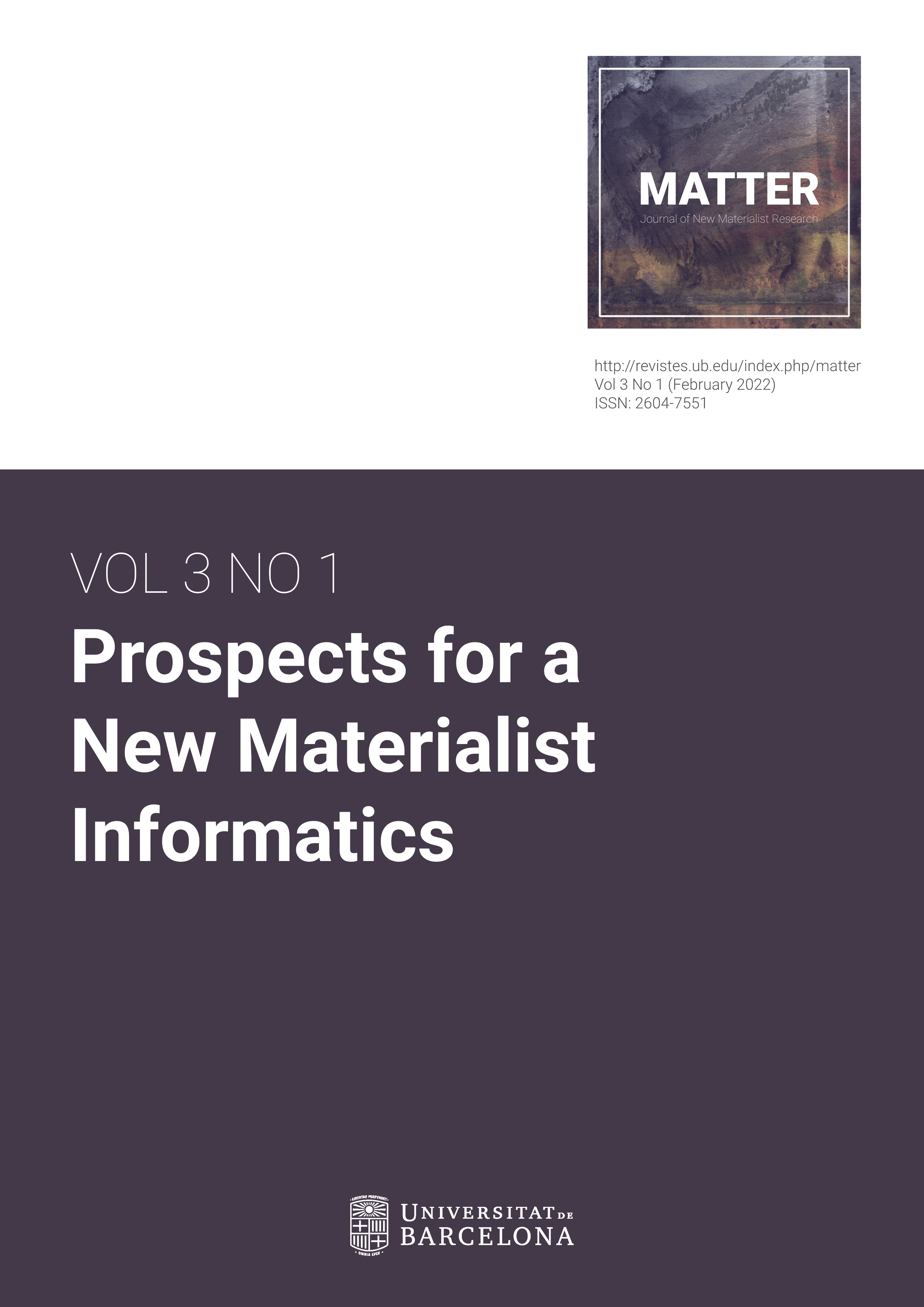Manifold Spaces and Patterned Potentialities
DOI:
https://doi.org/10.1344/jnmr.v3i1.38963Keywords:
Manifold; Design Patterns; City; Intensive variables; Dimensions; Apparatus.Abstract
The research aims at providing a new perspective and methodology to dynamic space setting as a mode articulation for intensity, transformation, and change pointing to more versatile, resilient, and ecological urban assemblages. The anticipation apparatus proposed for architecture and the city is a landscape of Alexandrian Design Patterns and intensive variables that simulates spatial contingencies and connects them with actual bodies as an extended mode of prediction and design. The city is represented as an N-dimensional manifold, a plane of variable dimensionality where its dimensions are used to represent its sociospatial becomings. At the same time, the manifold itself becomes the space of possible states that city can have, an apparatus that structures the city’s sociospatial potentialities and dynamically patterns its material reality.
Downloads
References
Alexander, Christopher et al. (1977). A Pattern Language: Towns, Buildings, Construction. New York, USA: Oxford University Press
Alexander, Christopher. (1968). Systems Generating Systems. In Architectural Design, 38, 605-610.
Bennett, Jane. (2004). The Force of Things: Steps Toward an Ecology of Matter. Political Theory, 32, no.3. (pp. 347—372). SAGE Publications.
Bonta, Mark and Protevi, John. (2006). Deleuze and geophilosophy. Edinburgh: Edinburgh University Press.
Braidotti, Rosi. (2017). Generative Futures: On Affirmative Ethics. In A. Radman and H. Sohn (Eds.), Critical and Clinical Cartographies (pp. 288-308). Edinburgh: Edinburgh University Press.
Coole, Diana and Frost, Samantha. (2010). New materialisms. Duke University Press.
DeLanda, Manuel. (2005). Space: Extensive and Intensive, Actual and Virtual. In I. Buchanan and G. Lambert (Eds.), Deleuze and Space (pp. 80—88). Edinburgh: Edinburgh University Press.
DeLanda, Manuel. (2005). Intensive Science and Virtual Philosophy. London and New York: Continuum.
DeLanda, Manuel. (2010). Deleuze: history and science. New York: Atropos Press.
Deleuze, Gilles and Parnet, Claire. (1987). Dialogues. New York: Columbia University Press.
Deleuze, Gilles., and Guattari, Felix. (1994). What is philosophy? New York: Columbia University Press.
Deleuze, Gilles. (2004). Difference and repetition. New York: Continuum.
Deleuze, Gilles. Trans. Boyman, Anne. (2012). Pure immanence: Essays on a Life. New York: Zone Books.
Deleuze, Gilles. (2007). Two regimes of madness (pp. 343—352). New York: Semiotext(e).
Deleuze, Gilles and Guattari, Felix and Massumi, Brian. (2005). A thousand plateaus. Minneapolis: University of Minnesota Press.
Galloway, Alexander R. and Thacker, Eugene. (2007). The exploit (pp 23—102). Minneapolis: University of Minnesota Press.
Gros, Stéphane, Russel, Kamala, and Stafford F. William Jr. (2019). "Topology as Method." Theorizing the Contemporary, Fieldsights, September 30. https://culanth.org/fieldsights/series/topology-as-method
Grosz, Elizabeth. (2018). Incorporeal : Ontology, Ethics, and the Limits of Materialism. New York: Columbia University Press.
Lury, Celia, Parisi, Luciana & Terranova, Tiziana. (2012). Introduction: The Becoming Topological of Culture. Theory, Culture & Society 29 (4-5). (pp. 3—35). SAGE Publications. https://doi.org/10.1177/0263276412454552
Marenko, Betti. (2015). The Un-designability of the Virtual. Design from Problem-solving to Problem-finding. In G. Sade, G. Coombs, A. McNamara (Eds.), Undesign. Critical Practices at the Intersections of Art and Design.
Massumi, Brian. (1998). Sensing the Virtual, Building the Insensible. In Perrella S. (Eds.) Architectural Design, special issue on 'Hypersurface Architecture', 68, no. 5-6 (1998). (pp. 16—24). https://doi.org/10.1177/135485659900500209
Massumi, Brian. (2002). Parables for the virtual. Durham, N.C.: Duke University Press.
Massumi, Brian. (July 19, 2007). Potential Politics and the Primacy of Preemption. Theory & Event, 10, 2. https://doi.org/10.1353/tae.2007.0066
M' Closkey, Karen & Vandersys, Keith. (2017). Dynamic Patterns: Visualizing Landscapes in a Digital Age. New York: Routledge.
Parisi, Luciana. (2012). Digital Design and Topological Control. Theory, Culture & Society 29 (4-5). (pp. 165—192). https://doi.org/10.1177/0263276412443568
Passia, Yota & Roupas, Panayotis. (2018). The contingent city: De-coding the possibilities of the city’s sociospatial metabolism. In S. Barbero (Eds.), Proceedings of RSD7, Relating Systems Thinking and Design 7.
Passia, Yota & Roupas, Panayotis. (2021). Hecate: An Apparatus for Mapping Urban Complexity. In P. Assis, P. Giudici & Orpheus Institute (Eds.), Machinic assemblages of desire: Deleuze and artistic research 3.
Sauvagnargues, Anne. (2015). In Marenko, B. & Brassett J. (Eds.), Deleuze and Design (pp. 58—83). Edinburgh: Edinburgh University Press.
Sha, Xin Wei. (July 01, 2012). Topology and Morphogenesis. Theory, Culture & Society, 29. (pp. 220—246). https://doi.org/10.1177/0263276412443570
Sha, Xin Wei & Plotnitsky, A. (2013). Poiesis and Enchantment in Topological Matter. Cumberland: MIT Press.
Smith, Daniel. W. (2012). Essays on Deleuze. Edinburgh: Edinburgh University Press: 189—221.
Steenson, Wright M. (2014). Architectures of Information: Christopher Alexander, Cedric Price, and Nicholas Negreponte & MIT’s Architecture Machine Group.
Downloads
Published
Issue
Section
License
Copyright (c) 2022 Matter: Journal of New Materialist Research

This work is licensed under a Creative Commons Attribution 4.0 International License.
The authors who publish in this journal agree to the following terms:- Authors retain copyright and grant the journal the right of first publication.
- Texts will be published under a Creative Commons Attribution License that allows others to share the work, provided they include an acknowledgement of the work’s authorship, its initial publication in this journal and the terms of the license.






